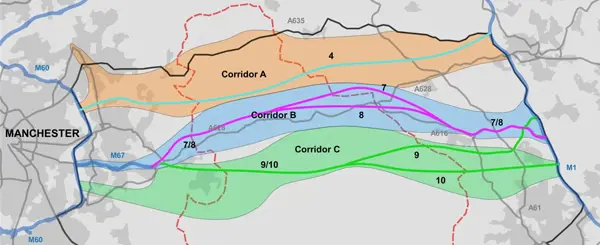The Government recently announced a shortlist of five potential routes for the proposed Trans-Pennine tunnel between Manchester and Sheffield, to support plans to build a Northern Powerhouse. The scheme would reportedly cost in the region of £6 billion. It is envisaged that the tunnel would almost halve journey times between the two cities, provide them and surrounding areas with an economic boost, and help protect the environment by reducing traffic through the Peak District National Park.
The tunnel is one of a number of projects that Transport for the North is working on, as well as other schemes such as Northern Powerhouse Rail, as part of a strategy to better connect the North and transform its economy. In effect, the strategy is to link Northern cities together to create one single economy, to rival other global cities. This approach has been inspired by examples such as the Randstad in the Netherlands and the Rhine-Ruhr in Germany.
However, a recent paper by think tank Centre for Cities
[1] suggests that the success of these areas does not appear to be based on the strength of their transport links. ‘
Building the Northern Powerhouse – Lessons from the Rhine-Ruhr and Randstad’ notes that commuting between city regions in these areas is not significantly greater than city regions in the North of England, nor are train journey times much quicker.
The paper suggests that the key lesson to be learnt from these areas is that strong regional economies require strongly performing cities at their heart. It notes that the national economy in Britain is concentrated within cities (cities account for 8% of land but 62% of output). Jobs cluster in specific places because of the benefits that density and proximity bring and these benefits increase the productivity of the jobs concerned. This phenomenon is known as agglomeration. With regard to harnessing the benefits of agglomeration, the paper identifies a number of findings when comparing the Northern Powerhouse and these two other areas in Northern Europe:
Centre for Cities considers that these five findings reveal two main characteristics about agglomeration in the Randstad and Rhine-Ruhr areas.
The paper notes that the most significant implication of the findings is that the underperformance of northern cities is not chiefly down to poor transport links between them. Instead, the model of the Randstad and the Rhine-Ruhr suggests that if the Northern Powerhouse is to be successful, then it must primarily focus upon making its cities more attractive to business investment. The suggested policy solution to these issues is to:
Based on
our own research, we also consider that a step change in housing provision and an increase in the rate of employment growth in regions such as Greater Manchester are central to ensuring the future success of the Northern Powerhouse.
This is not to say that improving transport links between northern cities is not important. Indeed, the Centre for Cities research suggests that there would be benefits from improving intercity transport links, particularly between Manchester and Leeds. The proposed HS2 route serving Leeds and Manchester, providing shorter journey times to the south, will also help to improve productivity and economic performance. However, it would appear that a more focussed approach to improving intra-city transport links within city regions is also required if the North is to truly thrive in the future and emulate the success of its European counterparts.



